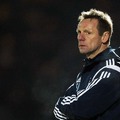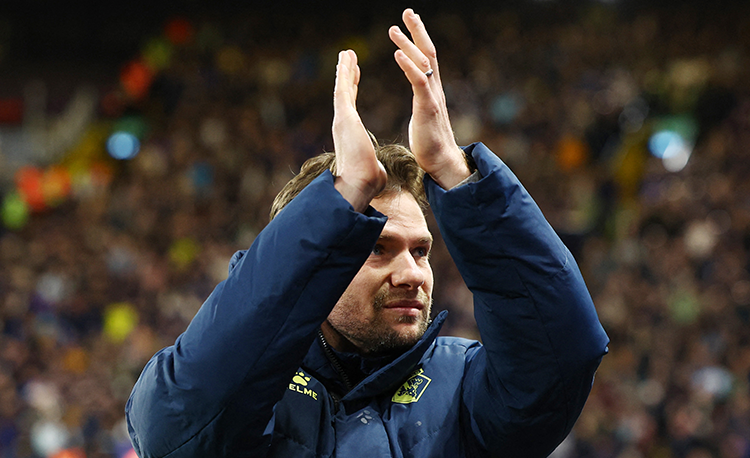Defending deep to counter-attack
This session looks at defending in your own half in order to counter-attack the opposition in an 11v11 practice.

| Area | Full pitch |
| Equipment | Balls, cones, goals |
| No. of Players | Up to 11v11 |
| Session Time | 20-40mins |
This session looks at defending in your own half in order to counter-attack the opposition in an 11v11 practice.
The importance of counter-attacking football in the modern game is very prevalent, with aggressive turnover of possession and quick, incisive responses all essential in order to attack out-of-balance opposition sides.
The practice should be performed once a week, whereby we might also bring in smaller non-11v11 practices, especially leading into away fixtures when this footballing style will be most needed.
What do I get the players to do?
We set up on a full-size pitch, as shown (1), and play a normal game, but with the premise being on the Aggressive Engagement Area (AEA) – see below.
1
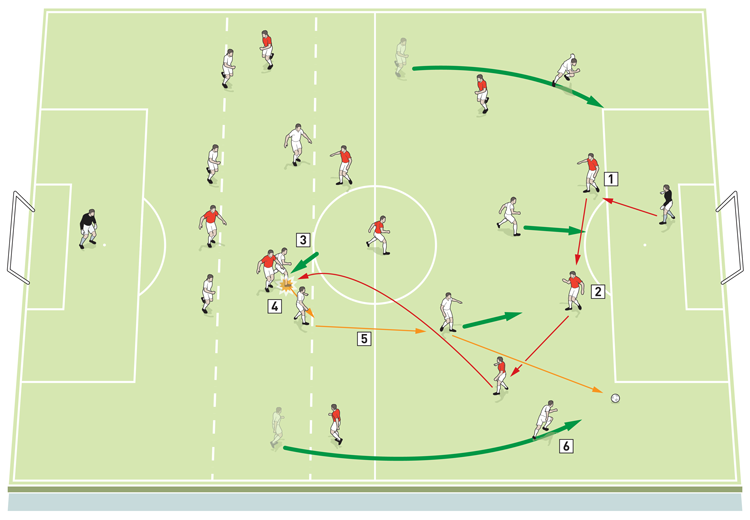
2. He passes to his fellow centre-back before the ball is released to the left-back
3. It moves through centre midfield where it hits the Aggressive Engagement Area
4. Defenders close in and go ‘touch tight’ against any opponents in this area
5. A strong and positive tackle is made, which provokes the counter-attack
6. Deep-sitting attackers now break into attacking positions
We want defenders to be set up no deeper than the edge of the box. This is how deep we would be willing to go in order to create space in the opponents’ half. At the other end, the striker would be just inside the opposition half and ready to break.
There are a few different ways we can start the practice – by feeding the ball into the attacking centre-half 10 yards inside his own half and, as he transfers the ball across the pitch, taking that time to coach the defensive team on their shape as they shuffle across the pitch. Alternatively we can start from a goal kick, or I might feed the ball into a midfield player with the attacking players in the defensive team ahead of the ball, therefore requiring recovery runs so that players get back into position.
What is key though is to let the attacking side play as they would in a game, whilst coaching the defensive unit on their shape, from back to front and side to side.
Aggressive engagement area
This area is pivotal to counter-attacking, the session itself and so many of our playing principles. It is coned off 10 yards from the edge of the box, across the full width of the pitch, until approximately 15 yards from the centre circle.
Whenever the ball is played into this part of the pitch there should be a defensive overload, with the defending team aggressive in their pursuit of winning possession. Players are constantly reminded - it’s no good dropping off if you’re not prepared to press the ball and defend in this area. So every time the ball is received here, a defending player should be ‘touch tight’ (similar to what you’d see in basketball) and ready to make a tackle as the ball arrives.
If the ball is on one side of the pitch, I want to see the opposite winger retreat to a defensive position but also one that will enable him to receive the ball and counter-attack if necessary (2).
2
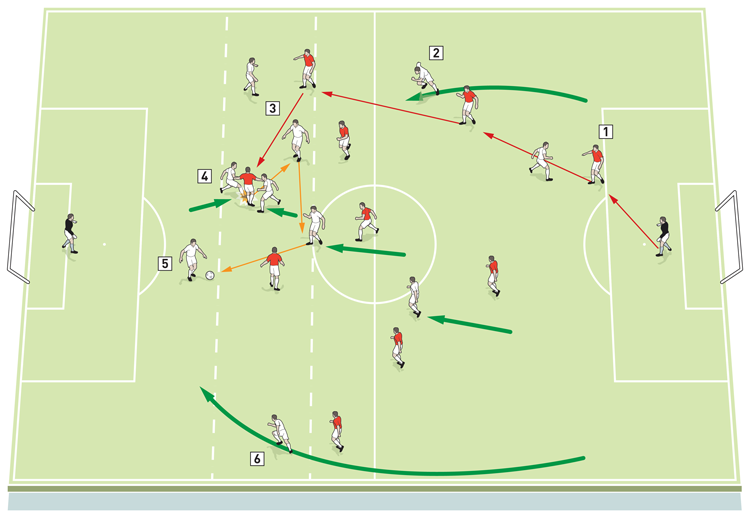
2. Counter-attacking whites must recover quickly to their defensive positions
3. A ball is played across the AEA
4. Here, a defender and midfielder compress from different sides to suffocate available space
5. As no clear counter-attcking option is available Whites retain possession
6. The attacking full-back must work hard to recover to his defensive position
What are the key things to look out for?
While players will develop specific instructions and aims within the context of protecting this key area, there are a number of technical and tactical ambitions to be accomplished in order to fully maximise each counter-attacking phase of play.
These include the depth of the team to start the practice, who engages, when and where, plus the compactness of the team and use of the AEA, of course. We also want to see every player aware of his role in creating good movement angles and runs so that the counter-attack has available outlets from the point of the turnover. Players must quickly identify when and where to deliver a pass on the counter-attack.
Typical mistakes
The most common mistake is getting into a compact shape but failing to press aggressively. We may also see players defending too high or too deep, and there can be a temptation to rush a pass on turnover of possession. And players must ‘read the game’, anticipating a situation before it has come about. In reality, this is something that can only be learned over time but players who cannot foresee situations will typically produce actions that lead to counter-attacks being slowed or failing completely.
How do I progress the session?
A key progression is individual instruction and encouragement for each player and the team duties as a whole, but we can look to put in place a more advanced press higher up the pitch. This would see us on the front foot and enforcing an earlier counter rather than letting play come onto us. We can also bring about different types of attacks - such as a long ball forward - to ensure we still get the right reaction (3).
3
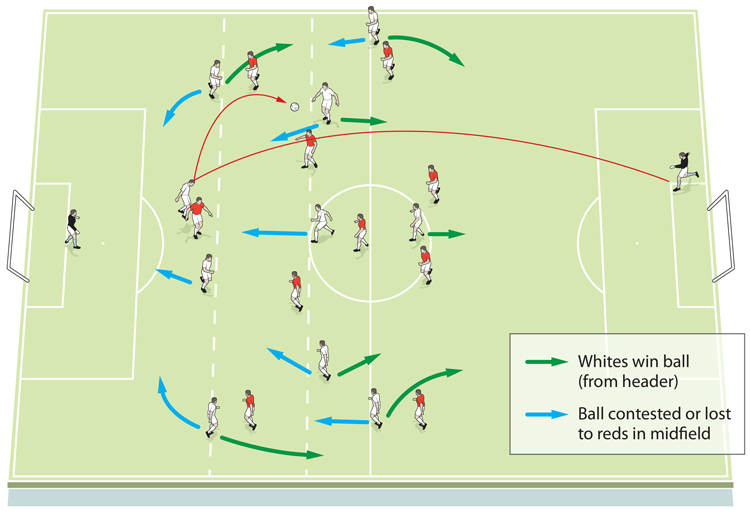
We might also break down the team units to add focus and detail, taking each group in isolation in order to work on the finer technical and tactical elements. From this we can bring in established position-specific techniques for certain players (for instance, a winger’s use of stepovers or a no.10’s skill at playing with his back to goal).
Editor's Picks
Attacking transitions
Deep runs in the final third
Using the goalkeeper in build-up play
Intensive boxes drill with goals
Penetrating the final third
Creating and finishing
My philosophy
Pressing initiation
Compact team movement
Coaches' Testimonials

Alan Pardew

Arsène Wenger

Brendan Rodgers

Carlos Carvalhal

José Mourinho

Jürgen Klopp

Pep Guardiola

Roy Hodgson

Sir Alex Ferguson

Steven Gerrard
Coaches' Testimonials

Gerald Kearney, Downtown Las Vegas Soccer Club

Paul Butler, Florida, USA

Rick Shields, Springboro, USA

Tony Green, Pierrefonds Titans, Quebec, Canada
Join the world's leading coaches and managers and discover for yourself one of the best kept secrets in coaching. No other training tool on the planet is written or read by the calibre of names you’ll find in Elite Soccer.
In a recent survey 92% of subscribers said Elite Soccer makes them more confident, 89% said it makes them a more effective coach and 91% said it makes them more inspired.
Get Monthly Inspiration
All the latest techniques and approaches
Since 2010 Elite Soccer has given subscribers exclusive insight into the training ground practices of the world’s best coaches. Published in partnership with the League Managers Association we have unparalleled access to the leading lights in the English leagues, as well as a host of international managers.
Elite Soccer exclusively features sessions written by the coaches themselves. There are no observed sessions and no sessions “in the style of”, just first-hand advice delivered direct to you from the coach.

